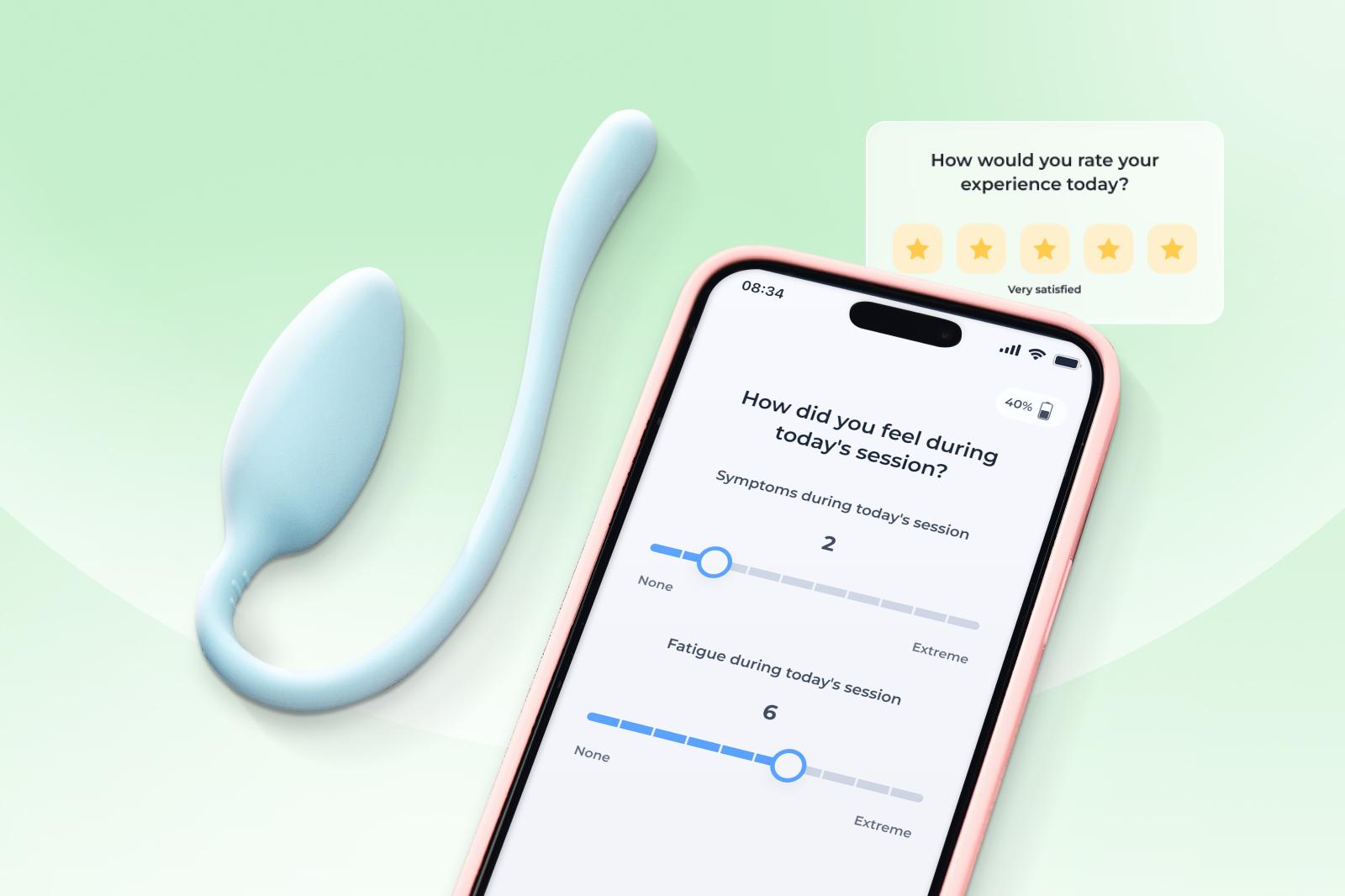Latest articles
Fresh healthcare insights

Passing on the Power of Pain Relief: Meet Sword Member Heidi
Heidi’s passion is for helping others. But after working as a registered dialysis nurse for 17 years, Heidi developed hand and wrist pain that prevented her from caring for her patients the way she always had. Heidi’s pain was affecting more than just her work life. A dedicated swimmer, biker, and grandmother, Heidi stays active in her personal life. She also loves horseback riding. “I was having trouble with my grip on my right hand, which is my reigning hand to control my horse.” To combat the pain, Heidi tried pain medication and even visited an orthopedist. “I went to see an orthopedic doctor, and he put a very painful injection in my wrist, which I didn’t get a lot of relief from.”
October 19, 2023 • 4 min read

New Study Shows Sword First to Provide an Equitable Solution for Pain
Nature Digital Medicine, the world’s leading medical journal covering all aspects of digital health, just published the results of a first-of-its-kind study assessing the ability of digital musculoskeletal (MSK) care to provide equitable rehabilitation to patients across various socioeconomic contexts. While it had been previously established that digital interventions reduce certain barriers to accessing MSK care, such as geographical and time constraints, this study was the first to explore whether digital MSK care can overcome other social determinants of health—such as education, economic stability, and cultural and community context. Using a validated metric derived from the U.S. census bureau, the study applied a social deprivation index (SDI) to over 12,000 chronic pain patients being treated with Sword Health’s digital physical therapy (PT) program.
October 17, 2023 • 6 min read

Sleep and Mental Health: The Science Behind It
Sleep is like a super pill. Consistent sleep can help your body fight off sickness, lower your risk of chronic diseases (like diabetes or heart disease to name a few), and can even help you heal after an injury. Sleep though isn’t just good for your physical health. It works undercover on pathways within your body to support and benefit your mental health too. Before you prepare to catch some Z’s, read below to learn how sleep helps your mind and body! Sleeping is sort of like plugging in your charger. While it may look like limited activity, underneath your body is setting the stage to get you ready to take on your week! We briefly talked about the physical benefits, but how does sleep help your mind, and mental state? Let’s break down some key factors that help with this: Neurotransmitter Regulation: Neurotransmitters are chemicals the brain releases to help both your brain and body communicate with each other and function fully. Dopamine is one of these released during deep sleep. This neurotransmitter helps with things like memory, concentration, and learning; but also helps with mood and physical movement. Serotonin also plays a role in learning, memory, happiness, and reward, as well as behavior, and appetite. The release of norepinephrine during sleep exerts effects on a variety of processes. This includes stress reduction, sleep cycles, and increased attention and focus.
September 20, 2023 • 4 min read

Sword Health Leads the Industry in Upper Limb Pain Care
According to the CDC, over 30% of U.S. adults experience upper limb pain. Often the result of musculoskeletal (MSK) disorders in the upper extremities, upper limb pain refers to pain in the shoulders, arms, wrists, hands, and neck. Pain in these areas can arise spontaneously or as a result of certain movements, or it may be more of a dull, consistent ache. Other symptoms such as numbness, weakness, stiffness, swelling, and/or tingling frequently co-occur with upper limb pain. Upper limb pain can be caused by MSK disorders such as: Work-related risk factors can cause or exacerbate MSK pain in the upper extremities, putting employees in certain occupations at higher risk than the general population. For instance, those who work with hand-held power tools or type on a computer for prolonged periods are especially susceptible to developing upper limb disorders and pain.
August 10, 2023 • 6 min read

What Sword Health’s Groundbreaking Study Means for Your Bottom Line
Last month, Nature Digital Medicine, the world’s preeminent peer-reviewed journal on all aspects of digital medicine and health, published a groundbreaking paper. The study reveals the results of a randomized controlled trial conducted by Sword Health in partnership with Emory University. The study demonstrated that Sword’s digital physical therapy (PT) program for low back pain (LBP) promotes the same levels of recovery as the highest-quality in-person PT, with no difference in primary outcomes (disability improvement) or secondary outcomes (pain, anxiety, depression, and overall productivity impairment) between the two groups. While the two groups’ clinical outcomes were comparable, the dropout rate was double for the in-person group compared to the digital group suggesting that digital care pathways are increasingly being accepted as the more accessible and engaging alternative to traditional healthcare models.
August 4, 2023 • 7 min read

Proactive pain care: the PQRST pain assessment and pain prevention advice
Most people only think about pain when it forces them to stop. By that point, it is often costly, disruptive, and difficult to treat. A better approach is to address pain before it spirals. That is the foundation of proactive pain care, an approach centered on early education, structured assessment, and consistent healthy movement. Instead of waiting for injuries to accumulate, proactive pain care helps people build resilience, strengthen awareness, and protect long-term wellbeing. This article explores why prevention of pain is so important, how pain education empowers people, and how proven frameworks like the PQRST pain assessment fit into the picture. You will also learn about the best program you can use to prevent pain with a proactive whole-body health plan that you can complete from the comfort of home. Musculoskeletal (MSK) conditions are the number one healthcare cost driver in the United States, responsible for an estimated $381 billion in annual direct healthcare expenditures¹. Beyond the financial impact, MSK pain affects daily life, reduces productivity, and often coexists with anxiety or depression.
July 27, 2023 • 8 min read

Study: Sword's digital physical therapy programs are the gold standard
Nature Digital Medicine study shows that Sword’s digital program delivers clinical outcomes equivalent to the best in-person care, with 2X improvement on the engagement challenges that plague traditional physical therapy NEW YORK – July 10, 2023 – Today, Sword Health, the world’s first end-to-end platform to predict, prevent and treat pain, is announcing its digital physical therapy program has been proven to be equally effective to the best in-person treatment, while making dramatic improvements in the compliance and engagement rates that have been long-standing challenges of traditional physical therapy. These findings, published in Nature Digital Medicine, are the result of a recently concluded randomized controlled trial conducted in partnership with the Physical and Rehabilitation Medicine Center at Emory University in Atlanta, Georgia.
July 10, 2023 • 5 min read

Promoting Regular Physical Movement: A Vital Component of Workplace Safety
Employers are required by law to foster a safe and healthful workplace that is free from serious hazards. But the savvy ones know that continually optimizing workplace safety is about more than following the law. Structured movement programs that encourage regular physical activity can prevent injury, chronic pain, and expensive musculoskeletal claims. The more effectively employers can protect their team from workplace injuries and illness, the more they stand to save on healthcare, workers’ compensation premiums, and fines for safety violations. According to Gallup, 75% of medical costs are accrued due to preventable conditions. Well-executed workplace safety programs increase systematic efficiencies by streamlining safety protocols, and they result in a healthier, more engaged, and more productive workforce.
June 22, 2023 • 7 min read

Inside Sword: From Advisor to Patient to Advocate
In 2020, Brian Marcotte joined Sword Health’s advisory board, committing to help us achieve our mission to free two billion from pain. As the former President and CEO of Business Group on Health, Brian is no stranger to innovative health and benefit solutions. His pivotal connection to Sword reinforces our mutual drive to transform healthcare systems, and patient access to them, across the globe. But Brian isn’t just a Sword advisor. He’s a member, too. In fact, having enrolled in Sword two years ago, he now believes our “clinical approach to digital physical therapy is superior to any other solution in the market” and he’s passionately advocating for it as a win-win solution for companies and their people. "I had a nagging, chronic back problem for years and tried to manage it through stretching and over-the-counter painkillers. While working out in June of 2021, however, I did something to trigger pain to the point where my range of motion was severely limited; just standing up first thing in the morning was enough for me to catch my breath.
May 8, 2023 • 4 min read

Making healthcare more equitable
Healthcare providers and employers understand that it’s critically important to recognize and tackle persistent health disparities to improve access and outcomes for everyone. But new requirements from the federal government mean addressing health equity is becoming even more urgent and necessary. Under the new ACO REACH payment model, participants will be required to meet several provisions on promoting health equity, including the creation of a health equity plan and the collection of health equity data to determine social risk factors.
April 26, 2023 • 8 min read

2 Clinical Studies Demonstrate that Sword Health Improves Outcomes and Advances Health Equity
Sword Health, the world’s fastest growing provider of digital care solutions for muscle, joint and pelvic pain, today announced two new studies that are the first to demonstrate that digital care programs can reduce pain and increase access to treatment for historically underserved patient populations, helping to advance health equity for all. Muscle and joint pain disproportionately affect people from different racial and ethnic backgrounds through higher disease burden. Historically underserved patients report greater rates of chronic pain, and less access to care, often due to lack of services in their communities. Access to healthcare is also a challenge for people living in rural areas, with fewer opportunities for in-person physical therapy and limited access to public transportation. In the first study, "Racial and Ethnic Differences in Outcomes of a 12-Week Digital Rehabilitation Program for Musculoskeletal Pain: Prospective Longitudinal Cohort Study" published in the Journal of Medical Internet Research, patients were organized by self-reported racial and ethnic groups. Their engagement and outcomes were measured after 12 weeks, compared to baseline.
March 2, 2023 • 5 min read

How MSK Problems Affect Sleep
We all know that sleep has a profound effect on your health and overall well-being. When pain makes it difficult to get a good night’s rest, it can affect nearly every aspect of your life, from your work productivity to your personal relationships. Research shows that pain and sleep have a bidirectional relationship. Chronic pain disturbs sleep, while sleep quality significantly predicts greater reports of pain. Since sleep is so vital for good health, this is a critical quality of life issue to resolve for people living with pain. This is also a cost-saving issue: Research shows that poor sleep quality costs businesses $1,967 per employee per year in lost productivity.
February 13, 2023 • 5 min read
For employers
Workplace health advice
How Digital Physical Therapy Improves Employee Retention
Did you know that fear of pain can be more disabling than pain itself? Chronic pain and employee turnover prevention are critically linked, but with the right MSK benefits coverage, employers can help their team members recover from pain to increase workplace productivity. Nearly 28% of people in the workplace will take leave for MSK pain over the course of a year. Patients who suffer the two most common conditions of low back and neck pain have an average return to work of 7 days. Overall, MSK conditions are responsible for 44 missed work days each year on average.
October 24, 2025 • 6 min read
How to evaluate and select the best digital MSK vendors
Musculoskeletal (MSK) disorders are one of the most expensive and under-addressed cost centers facing U.S. healthcare providers. MSK disorders affect 1 in 2 Americans and cost over $190 billion per year, more than heart disease, cancer, or mental health conditions. For employers and health plans, MSK claims are often among the top 3 cost drivers. And for members, chronic pain reduces quality of life, drives absenteeism, and often leads to costly downstream interventions. That’s why digital MSK solutions have surged in popularity. The promise is compelling: better access, which drives stronger engagement, delivers better outcomes, and therefore lowers overall healthcare costs.
October 24, 2025 • 6 min read
Reduce MSK costs with more effective digital MSK care plans
You’ve likely seen numerous digital health solutions that promise to lower medical spend. You’ve probably zeroed in on the top conditions with significant digital solutions in the marketplace: musculoskeletal (MSK), mental health, and diabetes. For most companies, prioritizing MSK care over other digital health solutions will drive the biggest benefits for your employees and your bottom line when it comes to savings. Given the multitude of vendors, platforms, and solutions available, prioritization can be a daunting task. How do you choose from among the thousands of digital health tools? What combination of condition focus and solution selection will drive the best outcomes for your population and the biggest return for your business?
October 24, 2025 • 5 min read
Tackling the #1 driver of employers’ health costs: MSK
The phrase ‘musculoskeletal disorder’ may not ring a bell — but the feeling might. The term refers to any type of pain in the muscles or joints, from chronic pain to injuries to post-surgical pain. Many of us have suffered from a musculoskeletal (MSK) issue at some point in our lives. In fact, one in two Americans is struggling with an MSK condition right now. And it’s causing economic ripples, especially in the workplace.
January 20, 2020 • 6 min read
Expert guidance
From the experts: Ask a physical therapist

Ask a PT: when is the best time to do my exercises?
Before I joined Sword Health, I worked in brick-and-mortar clinics. I never worked weekends, and rarely worked past 6 pm. My schedule was great...for me. But for my patients, it was a real challenge. Attending a physical therapy appointment might require leaving work early or slipping out at lunch. Even patients with more flexible schedules would sometimes lament about finding childcare or arranging transportation. A thirty-minute appointment could easily take an hour or even 90 minutes once travel was taken into account. When I was in a clinic, the “best” time for a patient to do their exercises was the time that worked for me, not for them. Sword's virtual model gives our members the power to do their exercises when AND where it's most convenient for them. Now that I work remotely for Sword, I’m able to help our members figure out the best time to do their exercises at home. Now, when my members ask me when they should do their exercises, I tell them - the best time is when you’ll actually do them!
February 11, 2021 • 6 min read

Ask a PT: Does walking really help with pain?
If you’ve ever stood on the sidelines of a sporting event, you’ve likely witnessed many falls, trips and tackles. Whether the players are small children or professional athletes, the advice from the coach may have simply been to “walk it off.” While that is not always the best solution after an acute injury, walking can be a really effective way to manage chronic pain. Motion is lotion. Movement increases blood flow, which brings nutrients to our tissues. It also helps those that don’t have blood flow, like cartilage. Cartilage lines our joints, absorbing impact. It’s surrounded by a liquid which provides it with nutrients, flowing in and out of it like a sponge. Exercise, like walking, causes loading that fills and squeezes that sponge, particularly in the joints of our legs and spine.
August 13, 2020 • 5 min read

Ask a PT: What Is Causing My Shoulder Pain?
When your shoulder hurts, it can be difficult to tell exactly what’s gone wrong. You’ve probably heard of pinched nerves and rotator cuff tears. Perhaps you’ve also heard about shoulders being ‘impinged’ or ‘frozen.’ It’s not easy to keep these various shoulder conditions straight, especially when they all cause similar pain symptoms. The first step towards fixing a problem is identifying it. This article, written by a team of Doctors of Physical Therapy, is designed to help you figure out what’s causing your shoulder pain — so you can begin the process of healing it. We will dive into the five most common causes of shoulder pain and how to differentiate them. Cervical refers to the neck, and radiculopathy is pain that radiates to another body part. Hence, cervical radiculopathy: a pinched nerve in the neck, which can cause radiating pain affecting the shoulder. It occurs when the cervical spine becomes damaged due to sudden injury or degeneration over time, and squeezes or puts pressure on a nearby nerve.
November 1, 2023 • 6 min read
Healthcare contributors
Meet Sword's expert authors

Dr. Vijay Yanamadala, MD, MBA, FAANS
Chief Medical Officer at Sword Health

Dr. Fernando Correia, M.D.
SVP Clinical & Regulatory Affairs at Sword Health

Megan Hill, PT, DPT
Director, Clinical Specialists

Morgan Hollis, MS, RDN
Head of Clinical Strategy, Sword Move

Jennesa Atherton
Head of Clinical Affairs, Sword Bloom

Liz Santo
Senior Clinical Program Manager, Sword Bloom ·





